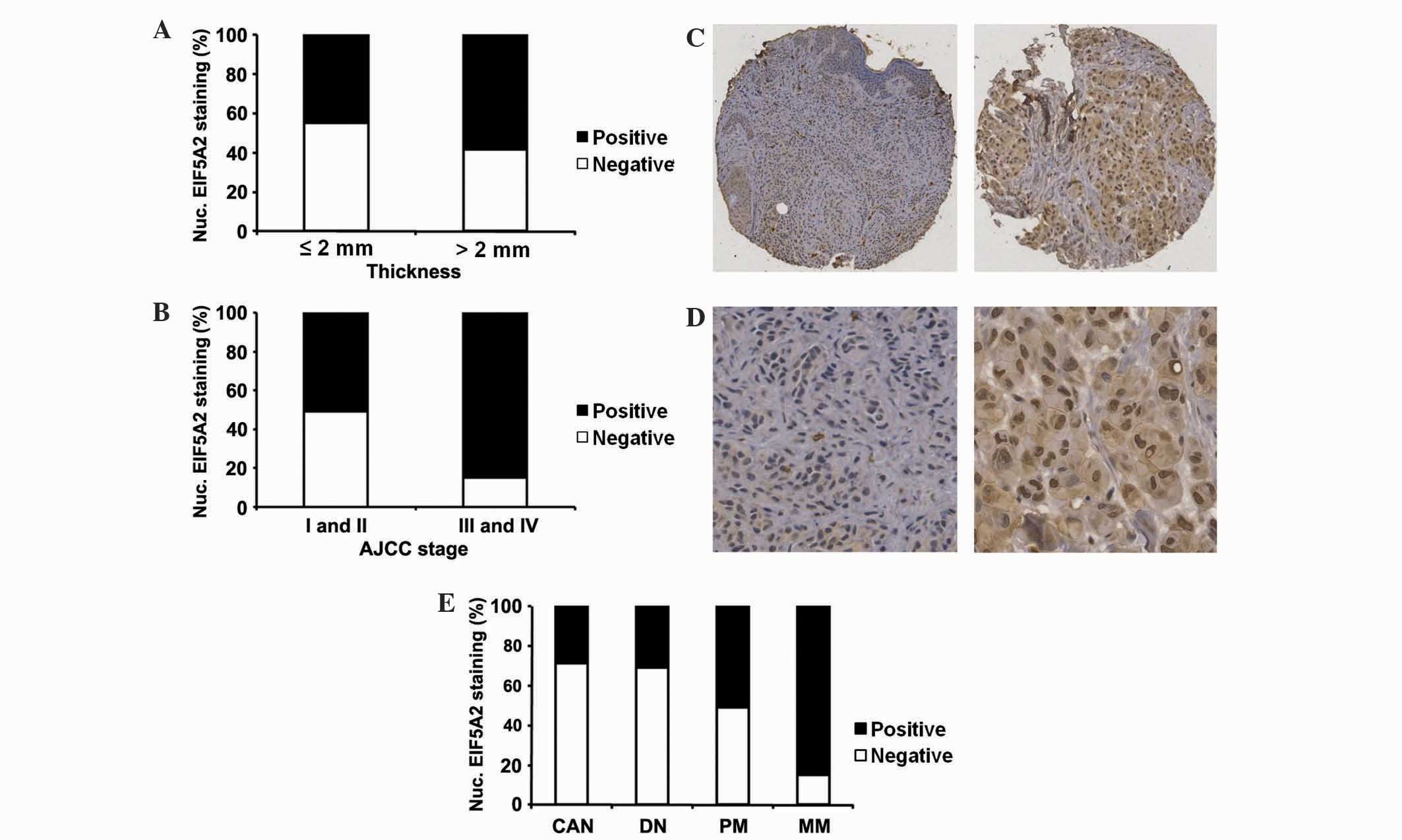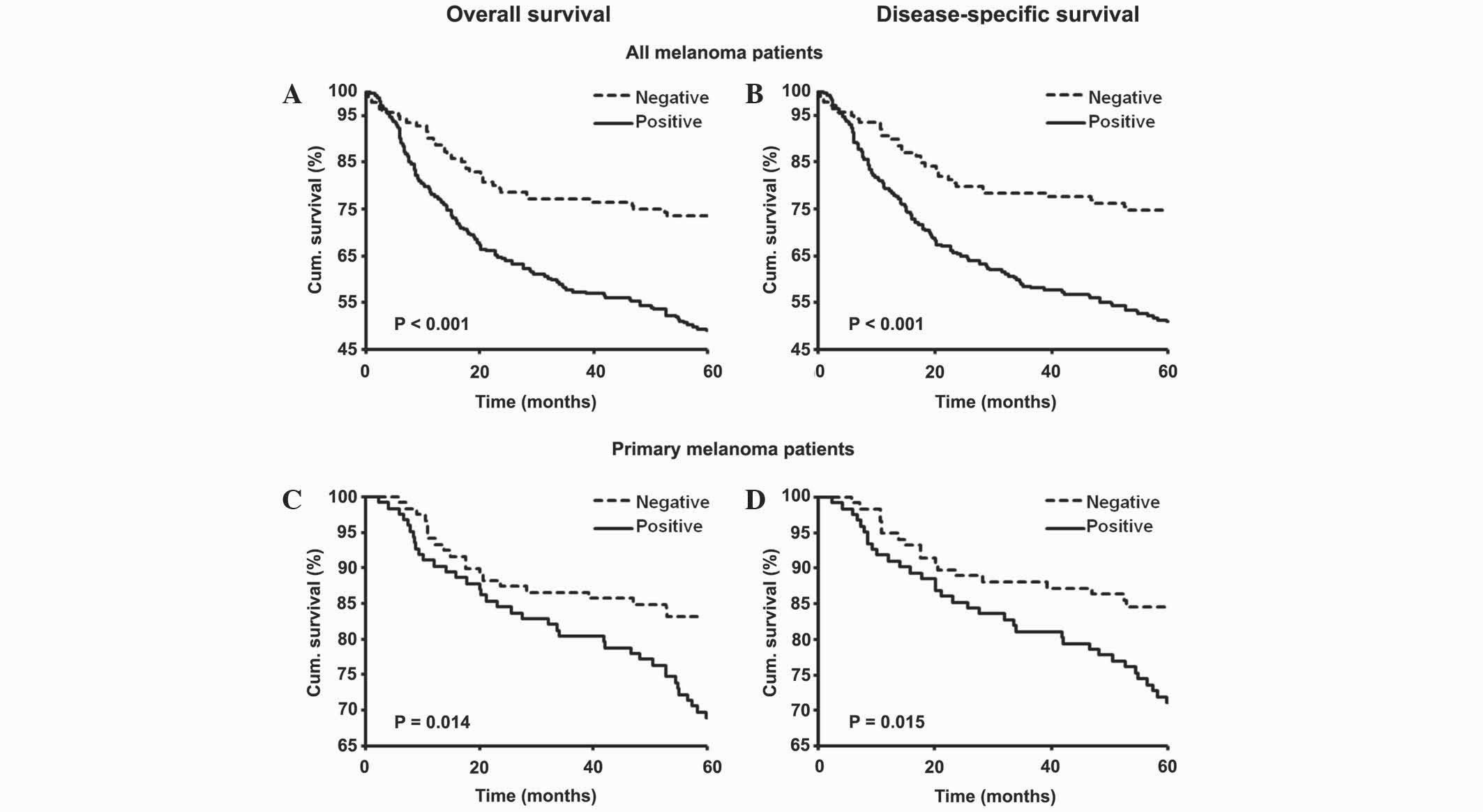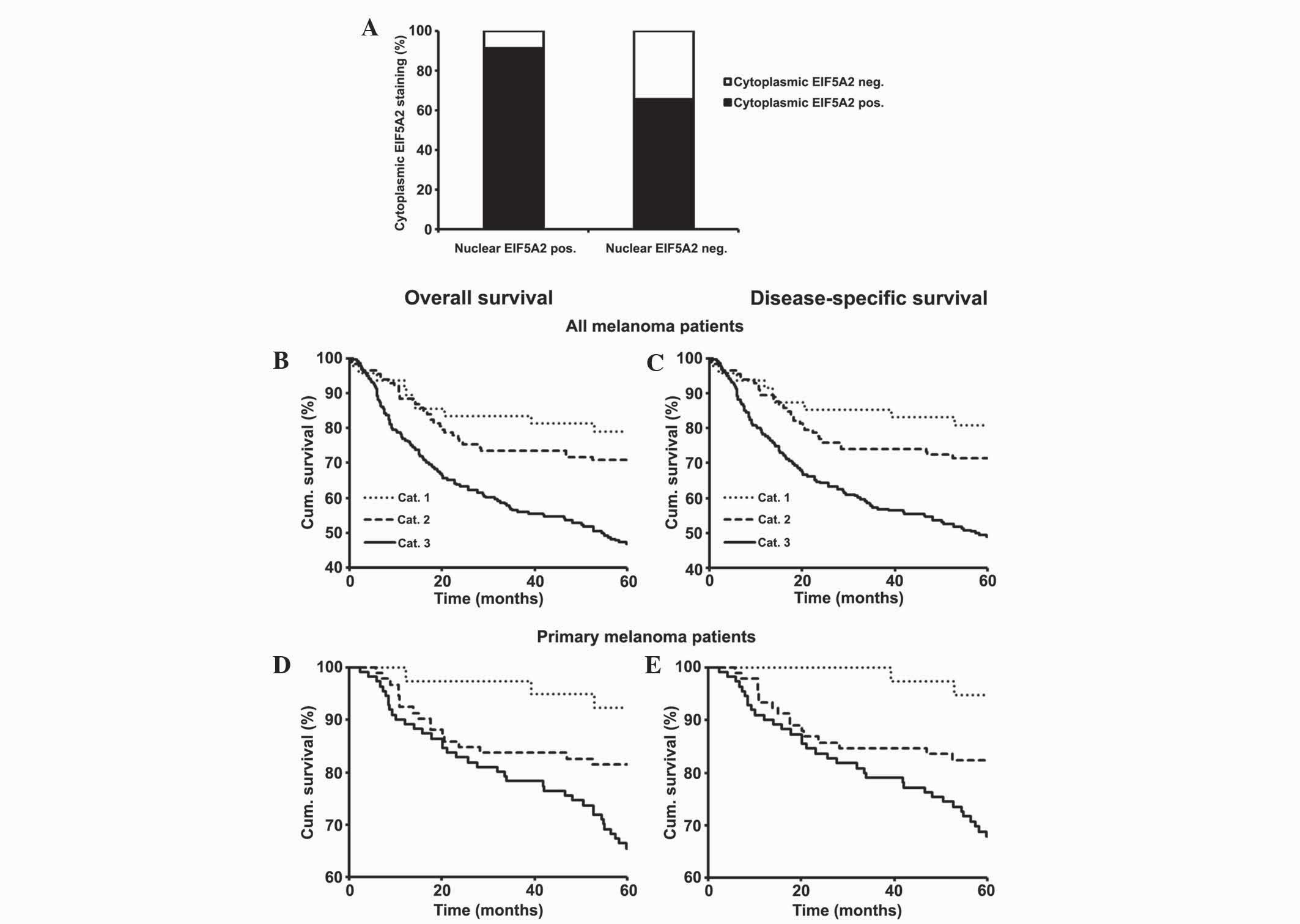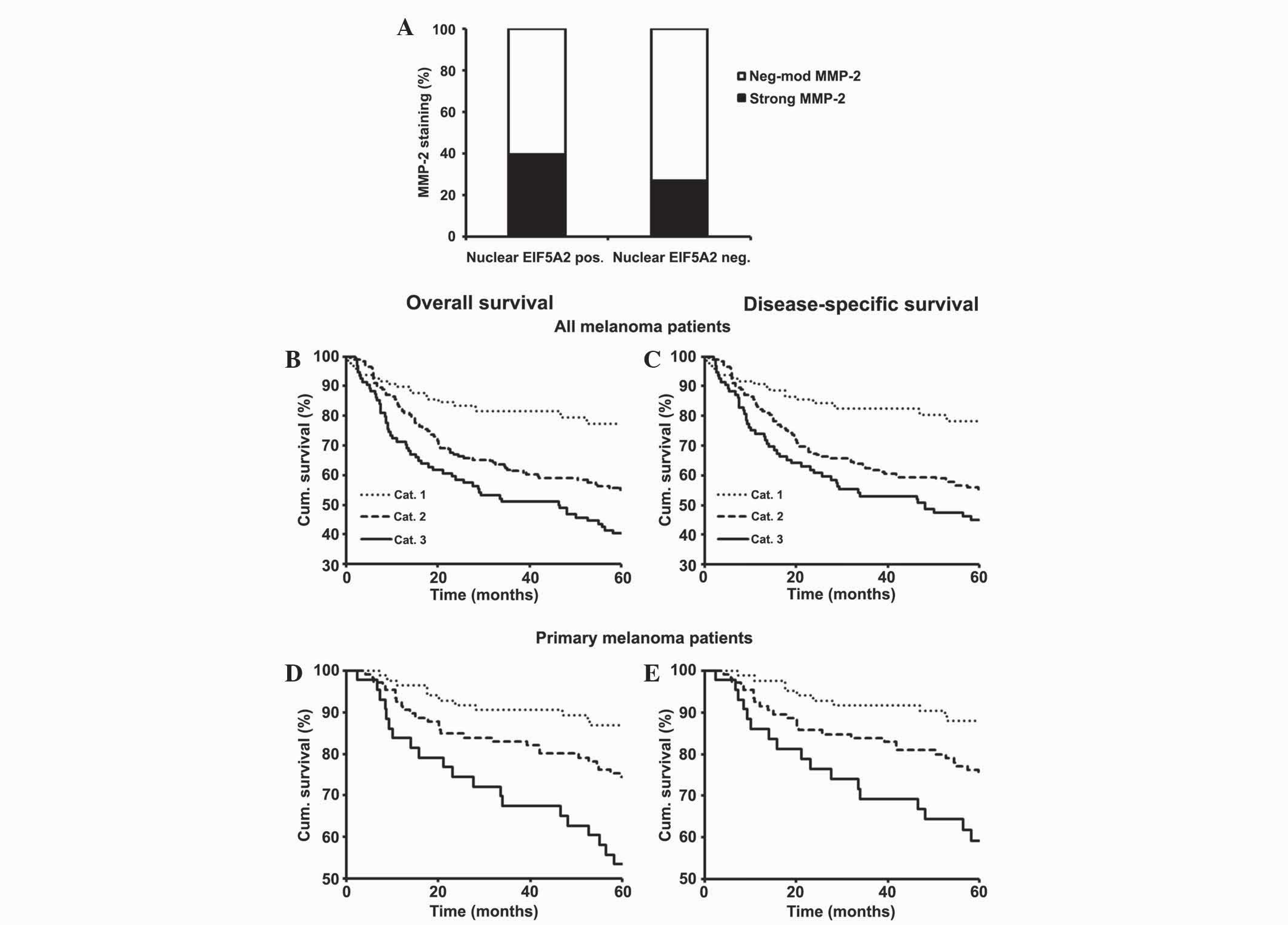|
1
|
Miller AJ and Mihm MC Jr: Melanoma. N Engl
J Med. 355:51–65. 2006. View Article : Google Scholar : PubMed/NCBI
|
|
2
|
Linos E, Swetter SM, Cockburn MG, Colditz
GA and Clarke CA: Increasing burden of melanoma in the United
States. J Invest Dermatol. 129:1666–1674. 2009. View Article : Google Scholar : PubMed/NCBI
|
|
3
|
Cummins DL, Cummins JM, Pantle H,
Silverman MA, Leonard AL and Chanmugam A: Cutaneous malignant
melanoma. Mayo Clin Proc. 81:500–507. 2006. View Article : Google Scholar : PubMed/NCBI
|
|
4
|
Saini P, Eyler DE, Green R and Dever TE:
Hypusine-containing protein eIF5A promotes translation elongation.
Nature. 459:118–121. 2009. View Article : Google Scholar : PubMed/NCBI
|
|
5
|
Patel PH, Costa-Mattioli M, Schulze KL and
Bellen HJ: The Drosophila deoxyhypusine hydroxylase homologue nero
and its target eIF5A are required for cell growth and the
regulation of autophagy. J Cell Biol. 185:1181–1194. 2009.
View Article : Google Scholar : PubMed/NCBI
|
|
6
|
Hauber I, Bevec D, Heukeshoven J, Krätzer
F, Horn F, Choidas A, Harrer T and Hauber J: Identification of
cellular deoxyhypusine synthase as a novel target for
antiretroviral therapy. J Clin Invest. 115:76–85. 2005. View Article : Google Scholar : PubMed/NCBI
|
|
7
|
Kruse M, Rosorius O, Kratzer F, Bevec D,
Kuhnt C, Steinkasserer A, Schuler G and Hauber J: Inhibition of
CD83 cell surface expression during dendritic cell maturation by
interference with nuclear export of CD83 mRNA. J Exp Med.
191:1581–1590. 2000. View Article : Google Scholar : PubMed/NCBI
|
|
8
|
Lipowsky G, Bischoff FR, Schwarzmaier P,
Kraft R, Kostka S, Hartmann E, Kutay U and Görlich D: Exportin 4: A
mediator of a novel nuclear export pathway in higher eukaryotes.
EMBO J. 19:4362–4371. 2000. View Article : Google Scholar : PubMed/NCBI
|
|
9
|
Hutten S and Kehlenbach RH: CRM1-mediated
nuclear export: To the pore and beyond. Trends Cell Biol.
17:193–201. 2007. View Article : Google Scholar : PubMed/NCBI
|
|
10
|
Maier B, Ogihara T, Trace AP, Tersey SA,
Robbins RD, Chakrabarti SK, Nunemaker CS, Stull ND, Taylor CA,
Thompson JE, et al: The unique hypusine modification of eIF5A
promotes islet beta cell inflammation and dysfunction in mice. J
Clin Invest. 120:2156–2170. 2010. View
Article : Google Scholar : PubMed/NCBI
|
|
11
|
Zuk D and Jacobson A: A single amino acid
substitution in yeast eIF-5A results in mRNA stabilization. EMBO J.
17:2914–2925. 1998. View Article : Google Scholar : PubMed/NCBI
|
|
12
|
Schrader R, Young C, Kozian D, Hoffmann R
and Lottspeich F: Temperature-sensitive eIF5A mutant accumulates
transcripts targeted to the nonsense-mediated decay pathway. J Biol
Chem. 281:35336–35346. 2006. View Article : Google Scholar : PubMed/NCBI
|
|
13
|
Jenkins ZA, Hååg PG and Johansson HE:
Human eIF5A2 on chromosome 3q25-q27 is a phylogenetically conserved
vertebrate variant of eukaryotic translation initiation factor 5A
with tissue-specific expression. Genomics. 71:101–109. 2001.
View Article : Google Scholar : PubMed/NCBI
|
|
14
|
Clement PM, Henderson CA, Jenkins ZA,
Smit-McBride Z, Wolff EC, Hershey JW, Park MH and Johansson HE:
Identification and characterization of eukaryotic initiation factor
5A-2. Eur J Biochem. 270:4254–4263. 2003. View Article : Google Scholar : PubMed/NCBI
|
|
15
|
Guan XY, Fung JM, Ma NF, Lau SH, Tai LS,
Xie D, Zhang Y, Hu L, Wu QL, Fang Y and Sham JS: Oncogenic role of
eIF-5A2 in the development of ovarian cancer. Cancer Res.
64:4197–4200. 2004. View Article : Google Scholar : PubMed/NCBI
|
|
16
|
Marchet A, Mocellin S, Belluco C, Ambrosi
A, DeMarchi F, Mammano E, Digito M, Leon A, D'Arrigo A, Lise M and
Nitti D: Gene expression profile of primary gastric cancer: Towards
the prediction of lymph node status. Ann Surg Oncol. 14:1058–1064.
2007. View Article : Google Scholar : PubMed/NCBI
|
|
17
|
Xie D, Ma NF, Pan ZZ, Wu HX, Liu YD, Wu
GQ, Kung HF and Guan XY: Overexpression of EIF-5A2 is associated
with metastasis of human colorectal carcinoma. Hum Pathol.
39:80–86. 2008. View Article : Google Scholar : PubMed/NCBI
|
|
18
|
Zhu W, Cai MY, Tong ZT, Dong SS, Mai SJ,
Liao YJ, Bian XW, Lin MC, Kung HF, Zeng YX, et al: Overexpression
of EIF5A2 promotes colorectal carcinoma cell aggressiveness by
upregulating MTA1 through C-myc to induce
epithelial-mesenchymaltransition. Gut. 61:562–575. 2012. View Article : Google Scholar : PubMed/NCBI
|
|
19
|
Tang DJ, Dong SS, Ma NF, Xie D, Chen L, Fu
L, Lau SH, Li Y, Li Y and Guan XY: Overexpression of eukaryotic
initiation factor 5A2 enhances cell motility and promotes tumor
metastasis in hepatocellular carcinoma. Hepatology. 51:1255–1263.
2010. View Article : Google Scholar : PubMed/NCBI
|
|
20
|
Yang GF, Xie D, Liu JH, Luo JH, Li LJ, Hua
WF, Wu HM, Kung HF, Zeng YX and Guan XY: Expression and
amplification of eIF-5A2 in human epithelial ovarian tumors and
overexpression of EIF-5A2 is a new independent predictor of outcome
in patients with ovarian carcinoma. Gynecol Oncol. 112:314–318.
2009. View Article : Google Scholar : PubMed/NCBI
|
|
21
|
He LR, Zhao HY, Li BK, Liu YH, Liu MZ,
Guan XY, Bian XW, Zeng YX and Xie D: Overexpression of eIF5A-2 is
an adverse prognostic marker of survival in stage I non-small cell
lung cancer patients. Int J Cancer. 129:143–150. 2011. View Article : Google Scholar : PubMed/NCBI
|
|
22
|
Chen W, Luo JH, Hua WF, Zhou FJ, Lin MC,
Kung HF, Zeng YX, Guan XY and Xie D: Overexpression of EIF-5A2 is
an independent predictor of outcome in patients of urothelial
carcinoma of the bladder treated with radical cystectomy. Cancer
Epidemiol Biomarkers Prev. 18:400–408. 2009. View Article : Google Scholar : PubMed/NCBI
|
|
23
|
Wei JH, Cao JZ, Zhang D, Liao B, Zhong WM,
Lu J, Zhao HW, Zhang JX, Tong ZT, Fan S, et al: EIF5A2 predicts
outcome in localised invasive bladder cancer and promotes bladder
cancer cell aggressiveness in vitro and in vivo. Br J Cancer.
110:1767–1777. 2014. View Article : Google Scholar : PubMed/NCBI
|
|
24
|
Zender L, Xue W, Zuber J, Semighini CP,
Krasnitz A, Ma B, Zender P, Kubicka S, Luk JM, Schirmacher P, et
al: An oncogenomics-based in vivo RNAi screen identifies tumor
suppressors in liver cancer. Cell. 135:852–864. 2008. View Article : Google Scholar : PubMed/NCBI
|
|
25
|
Khosravi S, Wong RP, Ardekani GS, Zhang G,
Martinka M, Ong CJ and Li G: Role of EIF5A2, a downstream target of
Akt, in promoting melanoma cell invasion. Br J Cancer. 110:399–408.
2014. View Article : Google Scholar : PubMed/NCBI
|
|
26
|
World Medical Association, . World Medical
Association Declaration of Helsinki: Ethical principles for medical
research involving human subjects. JAMA. 310:2191–2194. 2013.
View Article : Google Scholar : PubMed/NCBI
|
|
27
|
Dai DL, Martinka M and Li G: Prognostic
significance of activated Akt expression in melanoma: A
clinicopathologic study of 292 cases. J Clin Oncol. 23:1473–1482.
2005. View Article : Google Scholar : PubMed/NCBI
|
|
28
|
Zhang Z, Chen G, Cheng Y, Martinka M and
Li G: Prognostic significance of RUNX3 expression in human
melanoma. Cancer. 117:2719–2727. 2011. View Article : Google Scholar : PubMed/NCBI
|
|
29
|
Chen G, Cheng Y, Tang Y, Martinka M and Li
G: Role of Tip60 in human melanoma cell migration, metastasis, and
patient survival. J Invest Dermatol. 132:2632–2641. 2012.
View Article : Google Scholar : PubMed/NCBI
|
|
30
|
Jafarnejad SM, Ardekani GS, Ghaffari M,
Martinka M and Li G: Sox4-mediated Dicer expression is critical for
suppression of melanoma cell invasion. Oncogene. 32:2131–2139.
2013. View Article : Google Scholar : PubMed/NCBI
|
|
31
|
Soong SJ, Shaw HM, Balch CM, McCarthy WH,
Urist MM and Lee JY: Predicting survival and recurrence in
localized melanoma: A multivariate approach. World J Surg.
16:191–195. 1992. View Article : Google Scholar : PubMed/NCBI
|
|
32
|
Balch CM, Gershenwald JE, Soong SJ,
Thompson JF, Atkins MB, Byrd DR, Buzaid AC, Cochran AJ, Coit DG,
Ding S, et al: Final version of 2009 AJCC melanoma staging and
classification. J Clin Oncol. 27:6199–6206. 2009. View Article : Google Scholar : PubMed/NCBI
|
|
33
|
Gialeli C, Theocharis AD and Karamanos NK:
Roles of matrix metalloproteinases in cancer progression and their
pharmacological targeting. FEBS J. 278:16–27. 2011. View Article : Google Scholar : PubMed/NCBI
|
|
34
|
Rotte A, Martinka M and Li G: MMP2
expression is a prognostic marker for primary melanoma patients.
Cell Oncol (Dordr). 35:207–216. 2012. View Article : Google Scholar : PubMed/NCBI
|
|
35
|
Wang FW, Guan XY and Xie D: Roles of
eukaryotic initiation factor 5A2 in human cancer. Int J Biol Sci.
9:1013–1020. 2013. View Article : Google Scholar : PubMed/NCBI
|
|
36
|
Shaverdashvili K, Wong P, Ma J, Zhang K,
Osman I and Bedogni B: MT1-MMP modulates melanoma cell
dissemination and metastasis through activation of MMP2 and RAC1.
Pigment Cell Melanoma Res. 27:287–296. 2014. View Article : Google Scholar : PubMed/NCBI
|
|
37
|
Hofmann UB, Westphal JR, Waas ET, Zendman
AJ, Cornelissen IM, Ruiter DJ and van Muijen GN: Matrix
metalloproteinases in human melanoma cell lines and xenografts:
Increased expression of activated matrix metalloproteinase-2
(MMP-2) correlates with melanoma progression. Br J Cancer.
81:774–782. 1999. View Article : Google Scholar : PubMed/NCBI
|
|
38
|
Kurisaki A, Kurisaki K, Kowanetz M, Sugino
H, Yoneda Y, Heldin CH and Moustakas A: The mechanism of nuclear
export of Smad3 involves exportin 4 and Ran. Mol Cell Biol.
26:1318–1332. 2006. View Article : Google Scholar : PubMed/NCBI
|
|
39
|
Kau TR, Way JC and Silver PA: Nuclear
transport and cancer: From mechanism to intervention. Nat Rev
Cancer. 4:106–117. 2004. View
Article : Google Scholar : PubMed/NCBI
|














